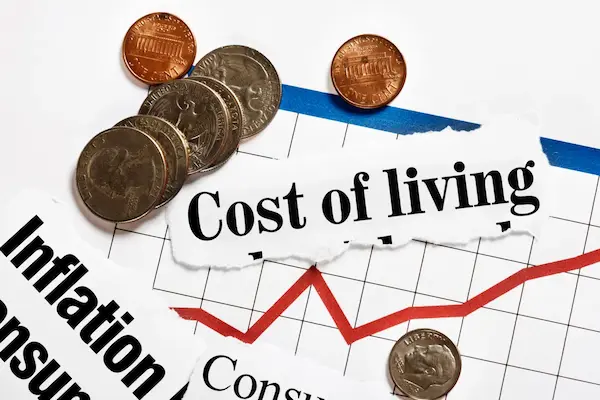
Inflation is a (usually negative) economic condition that significantly affects the economic life/well-being of the average person. Inflation causes currency/money to be worth less than previously, meaning a decrease in consumers’ purchasing power. As a result, people need to earn more money in order to maintain the same standard of living. For example, a person who earned $2,500 per month in July 2012, would have to make more than $3,200 per month in 2022, to maintain their standard of living (due to inflation) – a total increase of about 30%. Therefore, employers have to pay higher wages to employees as inflation increases. However, this increase in employee’s wages means that companies will have higher expenses, and will have to raise prices of their products/services to make up for it. This then contributes further to higher inflation rates, in a continuing cycle. In macroeconomics, this phenomenon is known as an Inflationary Spiral (or Wage-Price Spiral).
Inflation also leads to a rise in interest rates – which increases the cost of borrowing money, making it difficult for small businesses to expand/grow and hire new workers. As a result, inflation typically results in businesses finding ways to cut cost, whether by cutting wages or laying off employees – the opposite of the consumer/worker’s need. This can lead to an increase in unemployment rate and stagnation of wages, resulting in decreased consumer spending, leading to a recession.
Additionally, money pumped into the system as bail outs for corporates and relief measures for individuals (such as stimulus checks for pandemic relief or student debt forgiveness) causes many imbalances in the economy. Consumers have more expendable money, which increases demand for key goods/services, thereby increasing inflation.
Increased fears/consumer sentiment about inflation is another factor contributing to the rise in inflation. When consumers anticipate inflation and subsequent price gains, oftentimes people will “hoard” essential goods, leading to a sudden spike in demand, which supply cannot keep up with. This causes an increase in inflation, which further drives this cycle.
Inflation is more than just a recent issue – it has been at the forefront of economic discussions for more than the past few decades. President Ronald Reagan spent the first years of his US Presidency battling the problem of inflation, causing him to famously say that “Inflation is as violent as a mugger, as frightening as an armed robber, and as deadly as a hit man.” When he took office in 1980, US inflation had peaked at 15%, and the period between 1965 to 1982 was known as “The Great Inflation” – one of the most defining macroeconomic periods in the 20th century. Between 1979 and 1980, in the US, the number of people below the poverty level rose by 3.2 million (increased 12.3%). By 1981, approximately 1 out of every 7 persons in the US was living below the poverty level.
When inflation is high, everyone pays the price, but per the UPenn Wharton Budget Model (PWBM), poorest Americans have historically been hit the hardest as a result of higher prices of necessary goods and services. As of August 2022, the overall inflation rate is 8.3%, but certain essential sectors have much higher inflation rates (ex: Energy – 23.81% and Food – 11.40%). Households that have recently escaped poverty could be pushed back into it, due to rising inflation. A family in the lowest 20% of the income distribution typically spends around 15% of their budget on groceries – nearly 60% more than households in the top 20% of income. Wealthier households are able to afford to pay higher prices for goods/services, since they already have enough of a financial buffer/shield. This widening rich-poor inflation gap is known as inflation inequality.
Soaring prices are deepening the divide between the rich and the poor, and hence the government and policymakers are taking measures towards mitigating the impacts of unequal inflation. The government is exploring other methods of measuring inflation, by taking into account each demographic’s spending allocation, to help understand the magnitude of these disparities. For example, the inflation rate tends to disproportionately affect African American and Hispanic demographics more than White and Asian demographics. When the impact of inflation on each of the demographics is measured and recalculated into an inflation rate, African American and Hispanic demographics were faced with a 0.2-0.6% higher inflation rate than the US National Average, versus the Asian demographic which had a 0.5% lower inflation rate than the US National Average.
In an effort to decrease the effects of high inflation rates, President Joe Biden signed the Inflation Reduction Act of 2022 on August 16. This legislation is a significant breakthrough, as it aims to bring price relief to consumers and lower costs across health coverage, prescription drugs, home energy, electric vehicles, and more.
It is important that as a consumer, we understand the numerous factors that play a part in the rise of inflation rates, and its negative effects on millions of people globally, to make more informed and better decisions, and help support public policies and initiatives that aim to help all people aspire for a better economic well-being.


 Raj Mehta – Financial Education Instructor
Raj Mehta – Financial Education Instructor